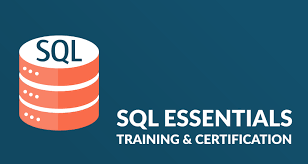SQL Essentials Training & Certification

CertOcean’s SQL essentials training & certification is sought
after web development jobs, web programming, data analysis, and
reporting professions. Figure out how to start scripting SQL (Structured
Query Language) utilizing Microsoft's SQL Server Management Studio
without any preparation or knowledge with SQL Essentials instructional
class's assistance.
Why opt for SQL Essentials?
* SQL
essentials training & certification are profoundly searched after
web programming, development and data analysis, and reporting
professions.
* SQL essentials training & certification is one of the most desired aptitudes and skills by recruiters.
* Remuneration of SQL Developer is $85,599 - Indeed.com.
Independent, Self-Paced Online Classes
Online
Self Learning Courses are intended for self-coordinated preparation,
permitting members to start whenever the timing is ideal with organized
practice and review the exercises to fortify learning. You'll learn
through recordings, PPTs, and complete tasks, projects, and different
activities intended to upgrade learning results, all on the occasion
that is generally advantageous to you.
Course Curriculum
Objective: Data Definition Commands characterizes the syntax of a single database and also
controls the database objects.
Module Objectives:
• RDBMS (Relational Database Management System) Outline
• Standardization in RDBMS
• Form data base items for example: Create the Table
• Delete database items, i.e., Erase database
• Alter database items, for example, changing the Column Name
• Create, modify and erase limitations and constraints
Points:
• Relation Database Management System (RDBMS)
• Standardization
• Create Database entities
• Data Types in SQL
• Amend Table Statements
• Drop Table Statements
• Innumerable Constraints
• Generating Views
Hands-On/Demo/Use-Case:
• Build Table With predefined Columns
• Addition of New Column to the prevailing table
• Check the imperatives on a table
• Addition of the Primary Key and also the Foreign Key on Table
• Removal of the Unique Constraint
Utilizing these orders, we can add, alter, or erase the data.
Module Objectives:
• Insertion to record/data in tables
• Alter/Up-to-date the current data
• Recover the data from the database from a distinct table
• Use of administrators for recovery of data
• Delete the specified data from tables
Topics:
• Inserting of Statements
• Insertion – As-Select Statement
• Up-to-date Statements
• Remove Statements
• Shorten Statements
• Select Statement
• Categorization and Filtering
• SQL – Wild Card
• The CASE Expression
Hands-On/Demo/Use-Case:
• Insertion of the records in a current table
• Delete specific records
• Updating of the database in the table based on the existing data on the other table.
Recover Data from Numerous Tables
Objective: To consolidates sections from different tables in a particular database by utilizing
values that are common to tables
Module Objectives:
• Recover records from various tables
Topics:
• Self-Join
• Left Join
• Right Join
• Inner Join
• Cross Join
Hands-On/Demo/Use-Case:
• Recover information from numerous tables
Module Objectives:
• Use of in-built functions
• Using Group by Command
• Utilizing Having Commands
Topics:
• Conversion Utility
• Logical Functions
• Math Functionality
• Aggregate Utilities
• String Utilities
• Date Functionality
Hands-On/Demo/Use-Case:
• Regulate the Count of rows fulfilling a specific condition
• Regulate average column
• Regulate Sum of the column
Objective: To make progressive database items for data control and recovery
Module Objectives:
• Develop Stored Procedure
• Implement Stored Procedure
• Develop the Functions
• Create Triggers
Subjects:
• Custom Functions
• Triggers
• Stored Procedure
Hands-On/Demo/Use-Case:
• Develop Functions
• Develop Triggers
• Develop and Integrate the Stored Procedure
Course Description
Here you are taught to figure out how to compose SQL (Structured Query Language) without any preparation or prior knowledge but only with SQL Essentials Training. This course will smoothly step you through composing and scripting the SQL utilizing Microsoft's SQL Server Management Studio. SQL Essentials permits you to recover, sort, group, filter, combine, and calculate the data to put away in a SQL Essentials Server data set. This course intends for individuals needing to figure out how to investigate data from a known database and control the data by inserting, updating, and deleting the records. Although we use SQL Server to examine data through this course, SQL is a standard language effectively adjusted to different RDBMS (social data set administration frameworks, for example, MySQL, Ingres, Sybase, IBM DB2, PostgreSQL, Oracle, and Microsoft Access.
• Define RDBMS and three standardization structures
• Utilizing the DDL Statements to develop and organize Tables
• Manipulation of the Data Utilizing DML
• Recovering of the Data and then Utilizing the SQL Select Statement
• Limiting and Categorization of the Data
• Presenting Data from Numerous Tables
• Utilizing the in-built functionalities
An excellent relational database, which sensibly puts data into lumps, is essentially used to store and put together much information. If you're hoping to recover any data from a database, you need to talk about its oral correspondence! The most generally utilized speech communication and post for interfacing with the database is SQL (Structured Query Language), the golden norm of relational databases.
SQL Essentials questions, which are demands or give directions that you send one database, permit you to recover data and update, embed, or erase data. SQL essentials training & certification is connected with the IT arena and is a traditional instrument for the database's administers. The developers use SQL to compose an application that requires a database connector, and system architects utilize it to plan for data set models. The entirety of this means worth that encyclopedism SQL essentials training & certification is an excellent decision for any individual who might want to be an IT professional.
* Creating a multi-table Relational Database
* Problems and activities are dependent on the given diagram. Twenty-five exercises are a part of the project.
There are no pre-necessities for this SQL essentials training course; notwithstanding, a few basics information about DBMS will be useful.
Features
Self-Paced Training
You will undergo self-paced learning where you will get an in-depth knowledge of various concepts that will be covered in the course.
Real-life Case Studies
Towards the course's finish, you will be taking a shot at a project that will test whether you can implement the techniques learned during the course.
Lifetime Access
You will get lifetime access to all the discussions, videos, and other learning substance inside the Learning Management System.
Certification
We ensure you as a specialist and certified expert in SQL based projects, and our expert panel reviews the project.
Discussion Forums
We have a network discussion community for every client that further encourages learning through interactions and knowledge sharing.
Frequently Asked Questions (FAQs):
You will never have to worry about missing a class with us. We have two alternatives from which you can choose:
• View the recorded meeting of the class accessible in your LMS.
• You can go to the missed class meeting and learning session in some other live batch.
We provide the manual needed for installing the Windows system and the step-by-step executive process that comes with screen captures.



